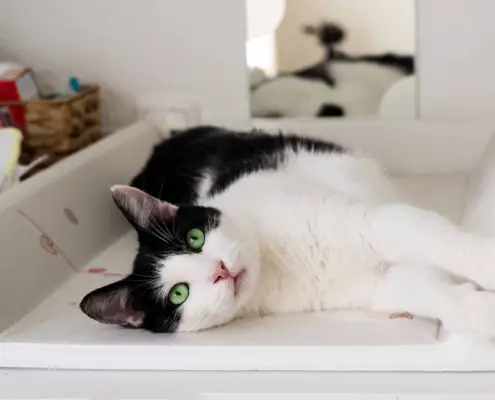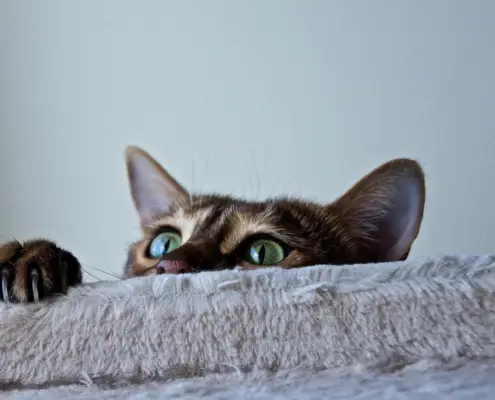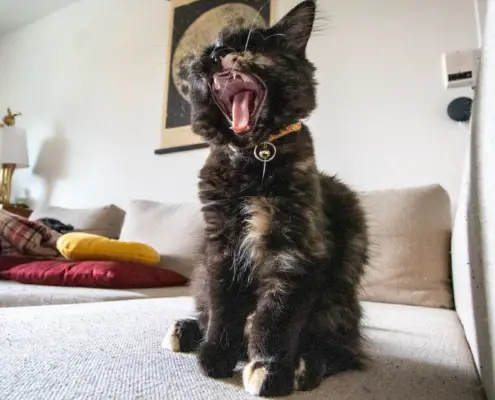
Cat genetics is a fascinating field that unveils the secrets behind the appearance, traits, and health of our feline friends. By understanding the basics of cat genetics, we can gain insights into the inheritance of coat colors, patterns, and even genetic disorders. In this comprehensive guide, we will delve into the world of cat genetics, unraveling its mysteries one gene at a time.
Understanding Basic Cat Genetics
To comprehend cat genetics, it’s important to grasp some fundamental concepts. At the most basic level, a cat’s genetic makeup is determined by its parents through the transmission of genes. Each gene carries information that influences a specific trait or characteristic. These genes come in pairs, with one inherited from the mother and the other from the father. By understanding how genes interact and express themselves, we can begin to decipher the genetic code of our beloved feline companions.
One of the key aspects of cat genetics is the idea of dominant and recessive genes. Dominant genes are expressed in an individual’s physical appearance, even if only one copy is present. On the other hand, recessive genes require two copies to manifest in the cat’s traits. This interplay between dominant and recessive genes contributes to the wide variety of coat colors, patterns, and other characteristics we observe in cats.
Coat Color Genetics in Cats
The coat color of a cat is determined by a complex interplay of multiple genes. It’s a captivating process that involves the interaction of genes responsible for pigmentation, dilution, and other factors. Understanding the basics of coat color genetics can help us appreciate the stunning array of colors and patterns exhibited by our feline companions.
Coat color in cats is primarily determined by two pigments: eumelanin, which produces black or brown colors, and pheomelanin, responsible for red and cream colors. The interplay between these two pigments, alongside other genetic factors, gives rise to the various coat colors we see in cats.
Additionally, the presence of certain genes can affect the dilution of these pigments, resulting in striking coat patterns such as tabbies, tortoiseshells, and calicoes. The intricate dance of genes involved in coat color and pattern inheritance is a testament to the complexity and beauty of cat genetics.
Patterns and Markings in Cat Genetics
Patterns and markings on a cat’s coat are determined by a combination of genetic factors. These characteristics add another layer of uniqueness to each individual cat, making them even more captivating.
One of the most well-known patterns in cat genetics is the tabby pattern. Tabby cats display distinctive stripes, swirls, or spots on their coats, which are a result of specific gene interactions. The tabby pattern can vary in intensity, with some cats having bold, clearly defined markings, while others possess a more subtle pattern.
Other coat patterns, such as solid, tortoiseshell, and pointed, are also determined by specific gene combinations. Each pattern is the result of intricate genetic interactions, giving cats their own individual style.
Genetic Disorders in Cats
While cats are generally healthy creatures, they can be prone to certain genetic disorders. These disorders are often inherited from their parents and can affect various aspects of their health and well-being.
One example of a genetic disorder in cats is polycystic kidney disease (PKD). This condition causes the formation of cysts in the kidneys, leading to kidney dysfunction. PKD is an autosomal dominant disorder, meaning that a cat only needs to inherit one copy of the faulty gene from either parent to develop the disease.
Another genetic disorder that affects cats is hypertrophic cardiomyopathy (HCM). HCM is a heart condition characterized by the thickening of the heart muscles, which can impair the heart’s ability to function properly. HCM can be inherited in a variety of ways, depending on the specific genetic mutation involved.
Breeding and Genetics in Cats
Breeding cats involves a careful selection of individuals with desirable traits to produce offspring that meet certain standards. Understanding the principles of genetics is crucial for responsible breeding practices, as it helps breeders predict the traits that offspring may inherit.
Selective breeding can be used to enhance certain traits, such as coat color, pattern, or body structure, while also minimizing the risk of inheriting genetic disorders. By utilizing knowledge of cat genetics, breeders can make informed decisions that contribute to the overall health and well-being of the breed.
Genetic Testing for Cats
Genetic testing has become an invaluable tool in the world of cat genetics. It allows breeders and cat owners to identify specific genetic markers or mutations that may be present in their cats. This information can be used to make informed breeding decisions, assess the risk of inherited disorders, or gain insights into the genetic makeup of their feline companions.
Genetic testing can help identify carriers of genetic disorders, enabling breeders to make informed decisions regarding breeding pairs. Additionally, genetic testing can provide valuable information about an individual cat’s ancestry, shedding light on their lineage and heritage.
Cat Genetics FAQs
Q: Can two black cats have a white kitten?
A: Yes, it is possible for two black cats to have a white kitten. This is due to the presence of a recessive gene for white coloration.
Q: How can I determine the color of my cat’s kittens?
A: The color of a cat’s kittens depends on the genetic makeup of both parents. By understanding the coat color genetics of the parent cats, it is possible to predict the potential colors of the offspring.
Q: Can cats with different coat colors produce kittens of the same color?
A: Yes, cats with different coat colors can produce kittens of the same color. This is because coat color genetics can be influenced by hidden recessive genes that are passed down through generations.
Resources for Further Learning About Cat Genetics
For those interested in delving deeper into the world of cat genetics, there are several resources available to expand your knowledge:
- Books: “Cat Genetics: The Basics” by Angela Shearman
- Online Communities: Join forums and groups dedicated to cat genetics to engage with other enthusiasts and experts.
- Veterinary Geneticists: Consult with veterinary geneticists who specialize in cat genetics for professional guidance and advice.
Conclusion
Cat genetics is a captivating field that unravels the mysteries behind the traits, colors, and patterns exhibited by our feline friends. By understanding the basics of cat genetics, we can appreciate the intricate genetic code that shapes our cats’ appearances and behaviors. Whether you are a breeder, owner, or simply a cat enthusiast, delving into the world of cat genetics will deepen your understanding and admiration for these marvelous creatures.
If you enjoyed my article, I would appreciate you sharing it with your network.

Sima Ndlebe
Sima writes for CatBuzz. He is interested in Cats, Health and Fitness, and Entrepreneurship.
Published: 23 October 2023



